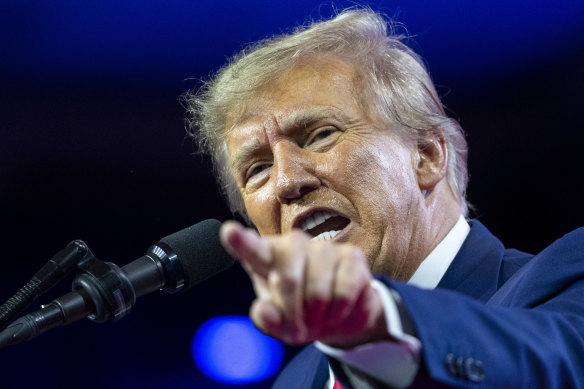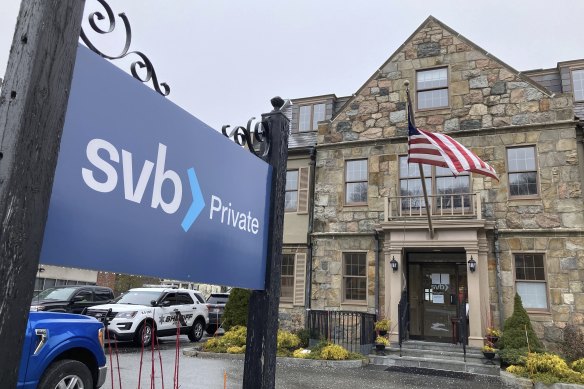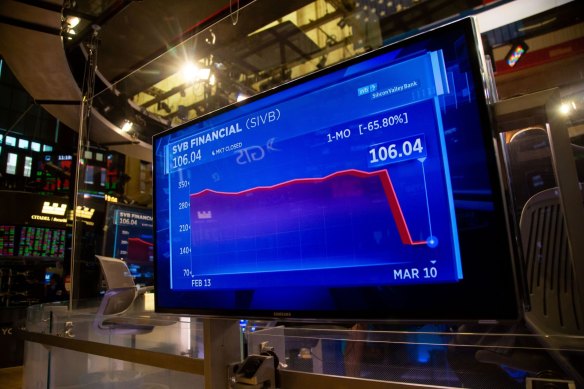Trump, the Fed and the implosion of one of America’s riskiest banks
When the world’s most influential central bank raises interest rates by 475 basis points in 12 months it is probable that something unexpected and unpleasant will occur. It just did, with the biggest US bank failure since the global financial crisis and, in nominal terms, the second-biggest US bank failure in history.
Silicon Valley Bank’s implosion is directly linked to the abrupt and aggressive shift in US monetary policy a year ago, after the Federal Reserve Board belatedly recognised that the spiralling US inflation rate wasn’t as transitory as it had thought.
Donald Trump played a big role in the collapse of Silicon Valley Bank.Credit:AP
The federal funds rate (akin to the Reserve Bank’s cash rate) went from zero to 4.75 per cent, with further increases foreshadowed.
Conventionally that shouldn’t have caused distress in a banking system that is generally more profitable when rates are rising and banks can increase their net interest margins by earning more on their free and low-cost deposit bases by charging higher rates on their lending.
SVB, however, wasn’t a conventional bank. It was the premier lender to venture capital-backed technology companies, boasting that it was the banker to about half the sector.
That appeared a winning strategy during and in the lead-up to the pandemic, when tech companies were booming and investors were throwing cash at them. It challenged, however, a central tenet of conservative banking by giving SVB a near-total concentration on a single sector.
It also produced a highly unconventional balance sheet. Banks make money by borrowing short via deposits and wholesale funding and lending long through a mix of mortgage and business lending.
SVB’s customer base, however, was flush with cash and didn’t need credit. SVB had grown, rapidly – from just over $US50 billion ($75.6 billion) in assets in 2018 to more than $US200 billion in 2023 – alongside the start-up companies it had backed. Part of the deal for accepting the high-risk business was that those customers deposited their spare cash with the bank.
That left it with a very odd balance sheet.
The tech companies didn’t need credit so, within a total asset base of $US209 billion, there were only $US74 billion of loans.
The companies were flush with cash, so SVB had about $US175 billion of deposits, including about $US157 billion of deposits that were above the $US250,000 cap for deposits insured by the Federal Deposit Insurance Corporation (FDIC). At the peak of the tech boom, deposits reached $US189 billion, three times their size two years before.
SVB was almost completely exposed to major losses if rates rose.Credit:AP
Given the lack of demand for credit from those cash-rich companies meant that those deposits couldn’t be profitably deployed via loans, about $US120 billion of SBV’s customers’ funds were invested in long-dated mortgage-backed securities and government bonds – at a time when interest rates were negligible but longer-duration securities provided the highest yields and profits (at somewhat higher risk).
Then, from March last year, rates started rising rapidly and aggressively, tech shares cratered and access to venture capital evaporated. The tech companies started drawing on their cash reserves to fund their businesses.
At the same time, as rates rose, the value of SVB’s fixed interest investments began to fall, on paper at least.
When interest rates rise, the value of bonds or mortgages with lower yields fall because anyone buying those securities will demand the equivalent of the market rate. To deliver that yield necessitates a sale at a discount to the face value of the security.
Banks hold portfolios of securities that they classify as either available for sale, where their value is marked to market, or held to maturity, where they are valued at their face value. If all of SVB’s investments were marked to market it would face losses of about $US15 billion and almost all of its equity of about $US16 billion would be wiped out.
That shouldn’t have been the case. Most banks would hedge most of the interest rate risks. Most banks would also have a far greater proportion of floating rate loans in their books than SVB and therefore far more of a natural hedge. SVB, however, had little if any hedging – it was almost completely exposed to major losses if rates rose.
When its customer started drawing on their deposits SVB needed to raise cash. It decided to sell most of its available-for-sale investments. It sold about $US20 billion – and lost $US1.8 billion when it crystallised what until then had been merely losses on paper.
To fill in the hole, and avoid unsettling its depositors, it decided to raise $US2.25 billion of equity.
The disclosure of the losses, and of the need for a capital raising, ignited fear within what is a close-knit venture capital community and a massive “run” on the bank started, with the $US42 billion withdrawn on Thursday forcing US financial regulators to seize control.
The concentrated customer base and the lop-sided balance sheet had made SVB peculiarly, perhaps uniquely, vulnerable to both the changed macro-economic settings and a run, although regulators will be hurriedly scouring the ranks of other smaller regional banks to see whether that combination exists elsewhere.
It could. The FDIC has estimated that US banks had unrealised losses on their available-for-sale portfolios of about $US620 billion as of December 31 last year. A year earlier that figure was $US8 billion.
Presumably the paper losses – if the securities were marked to market – on the held-to-maturity portfolios would be far, far larger. The better-managed banks would, of course, have hedged most, if not all, of their interest rate risk and therefore their net exposures would be a fraction of the gross.
Given the abruptness and magnitude of the shifts that have occurred and are still occurring, it is quite conceivable and even likely that there will be more unintended and unforseen consequences to flow from the biggest and quickest tightening of monetary settings in decades.
How could SVB have been allowed to construct such an unbalanced and exposed balance sheet? Where were the regulators?
After the 2008 financial crisis the US Congress enacted the Dodd-Frank Act, which imposed far more stringent and intrusive regulation on all US banks, including tough capital and liquidity requirements and regular stress testing for all banks with more than $US50 billion of assets.
In 2018, however, Donald Trump (in the midst of his war on regulation of all kinds) proudly signed a bill that rolled back most of those requirements for banks with less than $US250 billion of assets, leaving only about a dozen of the largest and most systemically important banks required to meet the Dodd-Frank rules.
Trump, and many Republicans, pondered aloud at the time about getting rid of Dodd-Frank even for the largest banks but thankfully didn’t get around to it. The core of the US system is, as are most banking systems elsewhere (including Australia’s), stringently regulated, soundly capitalised, holds high-quality liquidity and is regularly and rigorously stress-tested.
SVB’s shares tumbled prior to the collapse.Credit:Bloomberg
SVB was approaching $US200 billion of assets in 2018 and was one of the banks which lobbied hard to be free of the regulations.
One of the key requirements of those regulations was that banks hold enough high-quality liquidity to sustain a run for 30 days. SVB didn’t last 48 hours. It is inevitable that the question of how sub-$US250 billion banks should be regulated will be revisited.
The SVB collapse should be contained and the decision by Treasury Secretary Janet Yellen, Fed chair Jerome Powell and the FDIC’s Martin Gruenberg to make a “systemic risk exception” and guarantee all SVB depositors, whether insured or not, will be “made whole” ought to reduce the risk of contagion. The same protections will apply for Signature Bank, which was closed on Sunday (US time) by New York state regulators. The Fed is also making funding available to any bank experiencing liquidity issues in the fragile post-SVB collapse environment.
The episode, regardless of discrete impacts the collapse will have on other institutions and financial markets, is a reminder that big shifts in monetary policy do break things.
We saw an early sign of that last year when the UK pensions sector almost melted down overnight and the Bank of England was forced to intervene to lower yields in the UK gilts market.
Given the abruptness and magnitude of the shifts that have occurred and are still occurring, it is quite conceivable and even likely that there will be more unintended and unforseen consequences to flow from the biggest and quickest tightening of monetary settings in decades.
The Business Briefing newsletter delivers major stories, exclusive coverage and expert opinion. Sign up to get it every weekday morning.
Most Viewed in Business
From our partners
Source: Read Full Article


